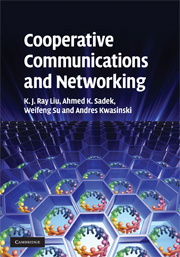1 - Introduction
from Part I - Background and MIMO systems
Published online by Cambridge University Press: 06 July 2010
Summary
Wireless communications have seen a remarkably fast technological evolution. Although separated by only a few years, each new generation of wireless devices has brought significant improvements in terms of link communication speed, device size, battery life, applications, etc. In recent years the technological evolution has reached a point where researchers have begun to develop wireless network architectures that depart from the traditional idea of communicating on an individual point-to-point basis with a central controlling base station. Such is the case with ad-hoc and wireless sensor networks, where the traditional hierarchy of a network has been relaxed to allow any node to help forward information from other nodes, thus establishing communication paths that involve multiple wireless hops. One of the most appealing ideas within these new research paths is the implicit recognition that, contrary to being a point-to-point link, the wireless channel is broadcast by nature. This implies that any wireless transmission from an end-user, rather than being considered as interference, can be received and processed at other nodes for a performance gain. This recognition facilitates the development of new concepts on distributed communications and networking via cooperation.
The technological progress seen with wireless communications follows that of many underlying technologies such as integrated circuits, energy storage, antennas, etc. Digital signal processing is one of these underlying technologies contributing to the progress of wireless communications. Perhaps one of the most important contributions to the progress in recent years has been the advent of MIMO (multiple-input multiple-output) technologies.
- Type
- Chapter
- Information
- Cooperative Communications and Networking , pp. 3 - 42Publisher: Cambridge University PressPrint publication year: 2008



